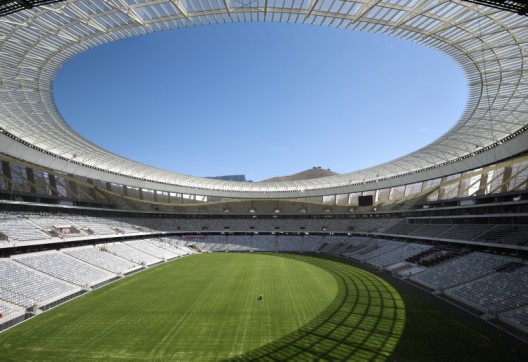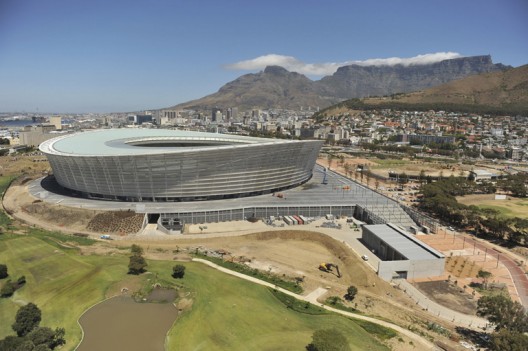More images and architect’s description after the break.
The geography of Cape Town is uniquely dominated by the contrast of the Table Mountain massif and Signal Hill with the gently undulating landscape and, sorrounding it all, the Atlantic Ocean. Greenpoint Stadium is a landmark building in the parkland of Greenpoint Common at the foot of Signal Hill, and blends respectfully with the landscape as a whole.
The outer shell of the stadium has been designed as an abstract, linearly articulated membrane structure. Its unique undulating silhouette – the result of the geometry of the stadium – gives the stadium the image of a sculptural object, enhancing its integration into the existing landscape.
The lightweight membrane structure consists of extensive concave features forming a uniform, flowing façade that follows the undulations. The light-colored glass fiber mesh boosts this effect, its coloration generating depth and vitality. The translucent surface absorbs and reflects the changing atmosphere of the daylight.
Designed for both football and rugby games, the stadium has three tiers with seats for about 68,000 spectators. The angle of inclination means that all the seats have the best possible sighting of the pitch. The interior of the stadium is designed to focus all attention on the pitch, thereby generating an atmosphere of intimacy and excitement.
The roof structure is a combination of a suspended roof with radial truss systems. The undulating roof is covered with laminated safety glass, and on the inside with a diaphanouse membrane skin. The space between the glass covering and the membrane integrates technical elements such as public address system and lighting as well as offering weather protection and a sound-absorbent volume.
For all its respectful understatement, the stadium will become a distinctive feature of the city. It improves the inmediate environment of Greenpoint Common and acts as a stimulus for other positive developments in the adjacent urban structure, the surrounding district and the whole urban environment.
- ©gmp – von Gerkan, Marg und Partner Architects, Berlin / Photo by: Marcus Bredt
- ©gmp – von Gerkan, Marg und Partner Architects, Berlin / Photo by: Marcus Bredt
- ©gmp – von Gerkan, Marg und Partner Architects / Photo by: Bruce Sutherland



No comments:
Post a Comment